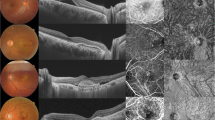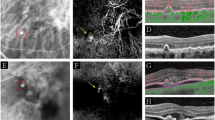Abstract
Background
To evaluate retinal thickness using spectral-domain optical coherence tomography (SD-OCT) with reduced speckle noise in eyes with polypoidal choroidal vasculopathy (PCV) compared to those with normal eyes and those with central serous chorioretinopathy (CSC).
Methods
We retrospectively reviewed cases of foveal serous retinal detachment in 36 eyes of 36 patients with active CSC and 23 eyes of 23 patients with active PCV, and 44 eyes of 44 normal subjects. Patients were examined using SD-OCT with reduced speckle noise, and the thickness of the outer nuclear layer (ONL), photoreceptor inner segment (IS), and photoreceptor outer segment (OS) were measured.
Results
The ONL and IS were thicker in normal eyes than in eyes with CSC or PCV (P < 0.001). The OS was significantly less thick in eyes with PCV than in normal eyes (P < 0.001), whereas there was no significant difference between eyes with CSC and normal eyes. The thickness of IS and OS in eyes with PCV was related to fibrin or hemorrhage being present in the subretinal space. In eyes with PCV, best-corrected visual acuity at baseline correlated with IS thickness (P = 0.023).
Conclusions
Thinning of each photoreceptor layer was observed in the eyes of PCV patients as compared to that observed in the case of normal individuals. The differentiating factors between PCV and CSC, observed using SD-OCT, include the thinning of the OS in eyes with PCV, which makes SD-OCT helpful in differentiating PCV from CSC. More severe photoreceptor alterations were seen in PCV, because fibrin and hemorrhage were present in the subretinal space, which correlated with poorer vision.




Similar content being viewed by others
References
Yannuzzi LA, Sorenson J, Spaide RF, Lipson B (1990) Idiopathic polypoidal choroidal vasculopathy (IPCV). Retina 10:1–8
Yannuzzi LA, Wong DW, Sforzolini BS, Goldbaum M, Tang KC, Spaide RF, Freund KB, Slakter JS, Guyer DR, Sorenson JA, Fisher Y, Maberley D, Orlock DA (1999) Polypoidal choroidal vasculopathy and neovascularized age-related macular degeneration. Arch Ophthalmol 117:1503–1510
Yannuzzi LA, Ciardella A, Spaide RF, Rabb M, Freund KB, Orlock DA (1997) The expanding clinical spectrum of idiopathic polypoidal choroidal vasculopathy. Arch Ophthalmol 115:478–485
Sasahara M, Tsujikawa A, Musashi K, Gotoh N, Otani A, Mandai M, Yoshimura N (2006) Polypoidal choroidal vasculopathy with choroidal vascular hyperpermeability. Am J Ophthalmol 142:601–607
Yannuzzi LA, Freund KB, Goldbaum M, Scassellati-Sforzolini B, Guyer DR, Spaide RF, Maberley D, Wong DW, Slakter JS, Sorenson JA, Fisher YL, Orlock DA (2000) Polypoidal choroidal vasculopathy masquerading as central serous chorioretinopathy. Ophthalmology 107:767–777
Moorthy RS, Lyon AT, Rabb MF, Spaide RF, Yannuzzi LA, Jampol LM (1998) Idiopathic polypoidal choroidal vasculopathy of the macula. Ophthalmology 105:1380–1385
Yannuzzi LA, Shakin JL, Fisher YL, Altomonte MA (1984) Peripheral retinal detachments and retinal pigment epithelial atrophic tracts secondary to central serous pigment epitheliopathy. Ophthalmology 91:1554–1572
Levine R, Brucker AJ, Robinson F (1989) Long-term follow-up of idiopathic central serous chorioretinopathy by fluorescein angiography. Ophthalmology 96:854–859
Guyer DR, Yannuzzi LA, Slakter JS, Sorenson JA, Ho A, Orlock D (1994) Digital indocyanine green videoangiography of central serous chorioretinopathy. Arch Ophthalmol 112:1057–1062
Piccolino FC, Borgia L (1994) Central serous chorioretinopathy and indocyanine green angiography. Retina 14:231–242
Scheider A, Nasemannn JE, Lund OE (1993) Fluorescein and indocyanine green angiographies of central serous choroidopathy by scanning laser ophthalmoscopy. Am J Ophthalmol 115:50–56
Prunte C, Flammer J (1996) Choroidal capillary and venous congestion in central serous chorioretinopathy. Am J Ophthalmol 121:26–34
Iida T, Kishi S, Hagimura N, Shimizu K (1999) Persistent and bilateral choroidal vascular abnormalities in central serous chorioretinopathy. Retina 19:508–512
Fujimoto H, Gomi F, Wakabayashi T, Sawa M, Tsujikawa M, Tano Y (2008) Morphologic changes in acute central serous chorioretinopathy evaluated by Fourier-domain optical coherence tomography. Ophthalmology 115:1494–1500
Wojtkowski M, Srinivasan V, Fujimoto JG, Ko T, Schuman JS, Kowalczyk A, Duker JS (2005) Three-dimensional retinal imaging with high-speed ultrahigh-resolution optical coherence tomography. Ophthalmology 112:1734–1746
Hangai M, Ojima Y, Gotoh N, Inoue R, Yasuno Y, Makita S, Yamanari M, Yatagai T, Kita M, Yoshimura N (2007) Three-dimensional imaging of macular holes with high-speed optical coherence tomography. Ophthalmology 114:763–773
Ooto S, Hangai M, Sakamoto A, Tomidokoro A, Araie M, Otani T, Kishi S, Matsushita K, Maeda N, Shirakashi M, Abe H, Takeda H, Sugiyama K, Saito H, Iwase A, Yoshimura N (2010) Three-dimensional profile of macular retinal thickness in normal Japanese eyes. Invest Ophthalmol Vis Sci 51:465–473
Sakamoto A, Hangai M, Yoshimura N (2008) Spectral-domain optical coherence tomography with multiple B-scan averaging for speckle-noise-reduced imaging of retinal diseases. Ophthalmology 115:1071–1078
Spaide RF, Klancnik JM Jr (2005) Fundus autofluorescence and central serous chorioretinopathy. Ophthalmology 112:825–833
Iida T, Hagimura N, Sato T, Kishi S (2000) Evaluation of central serous chorioretinopathy with optical coherence tomography. Am J Ophthalmol 129:16–20
Matsumoto H, Kishi S, Otani T, Sato T (2008) Elongation of photoreceptor outer segment in central serous chorioretinopathy. Am J Ophthalmol 145:162–168
Ojima Y, Hangai M, Sasahara M, Gotoh N, Inoue R, Yasuno Y, Makita S, Yatagai T, Tsujikawa A, Yoshimura N (2007) Three-dimensional imaging of the foveal photoreceptor layer in central serous chorioretinopathy using high-speed optical coherence tomography. Ophthalmology 114:2197–2207
Iijima H, Imai M, Gohdo T, Tsukahara S (1999) Optical coherence tomography of idiopathic polypoidal choroidal vasculopathy. Am J Ophthalmol 127:301–305
Iijima H, Iida T, Imai M, Tsukahara S (2000) Optical coherence tomography of orange-red subretinal lesions in eyes with idiopathic polypoidal choroidal vasculopathy. Am J Ophthalmol 129:21–26
Sato T, Kishi S, Watanabe G, Matsumoto H, Mukai R (2007) Tomographic features of branching vascular networks in polypoidal choroidal vasculopathy. Retina 27:589–594
Kameda T, Tsujikawa A, Otani A, Sasahara M, Gotoh N, Tamura H, Yoshimura N (2007) Polypoidal choroidal vasculopathy examined with en face optical coherence tomography. Clin Experiment Ophthalmol 35:596–601
Kon Y, Iida T, Maruko I, Saito M (2008) The optical coherence tomography-ophthalmoscope for examination of central serous chorioretinopathy with precipitates. Retina 28:864–869
Tsujikawa A, Sasahara M, Otani A, Gotoh N, Kameda T, Iwama D, Yodoi Y, Tamura H, Mandai M, Yoshimura N (2007) Pigment epithelial detachment in polypoidal choroidal vasculopathy. Am J Ophthalmol 143:102–111
Ojima Y, Hangai M, Sakamoto A, Tsujikawa A, Otani A, Tamura H, Yoshimura N (2009) Improved visualization of polypoidal choroidal vasculopathy lesions using spectral-domain optical coherence tomography. Retina 29:52–59
Wolf-Schnurrbusch UE, Ceklic L, Brinkmann CK, Iliev ME, Frey M, Rothenbuehler SP, Enzmann V, Wolf S (2009) Macular thickness measurements in healthy eyes using six different optical coherence tomography instruments. Invest Ophthalmol Vis Sci 50:3432–3437
Yamada E (1969) Some structural features of the fovea centralis in the human retina. Arch Ophthalmol 82:151–159
Matsumoto H, Sato T, Kishi S (2009) Outer nuclear layer thickness at the fovea determines visual outcomes in resolved central serous chorioretinopathy. Am J Ophthalmol 148:105–110
Marmor MF (1999) Mechanisms of fluid accumulation in retinal edema. Doc Ophthalmol 97:239–249
Acknowledgement
We wish to thank the imaging specialists of Kyoto University OCT Reading Center (Mayumi Yoshida and Akiko Hirata) for measuring retinal thickness.
Author information
Authors and Affiliations
Corresponding author
Additional information
Support
This research was supported in part by a Grant-in-Aid for Scientific Research (21796179) from the Japan Society for the Promotion of Science (JSPS).
All authors have full control of all primary data, and agree to allow Graefe's Archive for Clinical and Experimental Ophthalmology to review our data upon request.
Financial Disclosures
No author has any financial interest/conflict of interest to disclose.
Electronic supplementary material
Below is the link to the electronic supplementary material.
Table 1
Retinal thickness at the baseline and at last follow-up in subjects over 60 years old without fibrin or hemorrhage in the subretinal space (DOC 48 kb)
Rights and permissions
About this article
Cite this article
Ooto, S., Tsujikawa, A., Mori, S. et al. Thickness of photoreceptor layers in polypoidal choroidal vasculopathy and central serous chorioretinopathy. Graefes Arch Clin Exp Ophthalmol 248, 1077–1086 (2010). https://doi.org/10.1007/s00417-010-1338-5
Received:
Revised:
Accepted:
Published:
Issue Date:
DOI: https://doi.org/10.1007/s00417-010-1338-5




